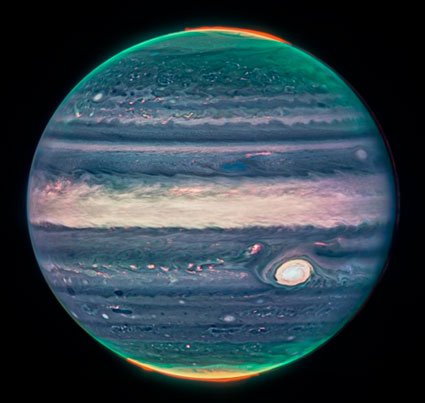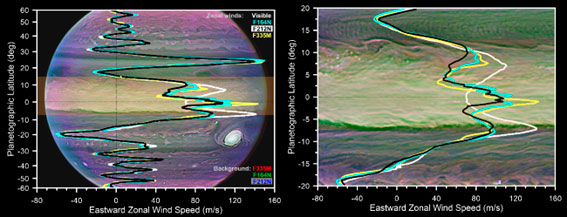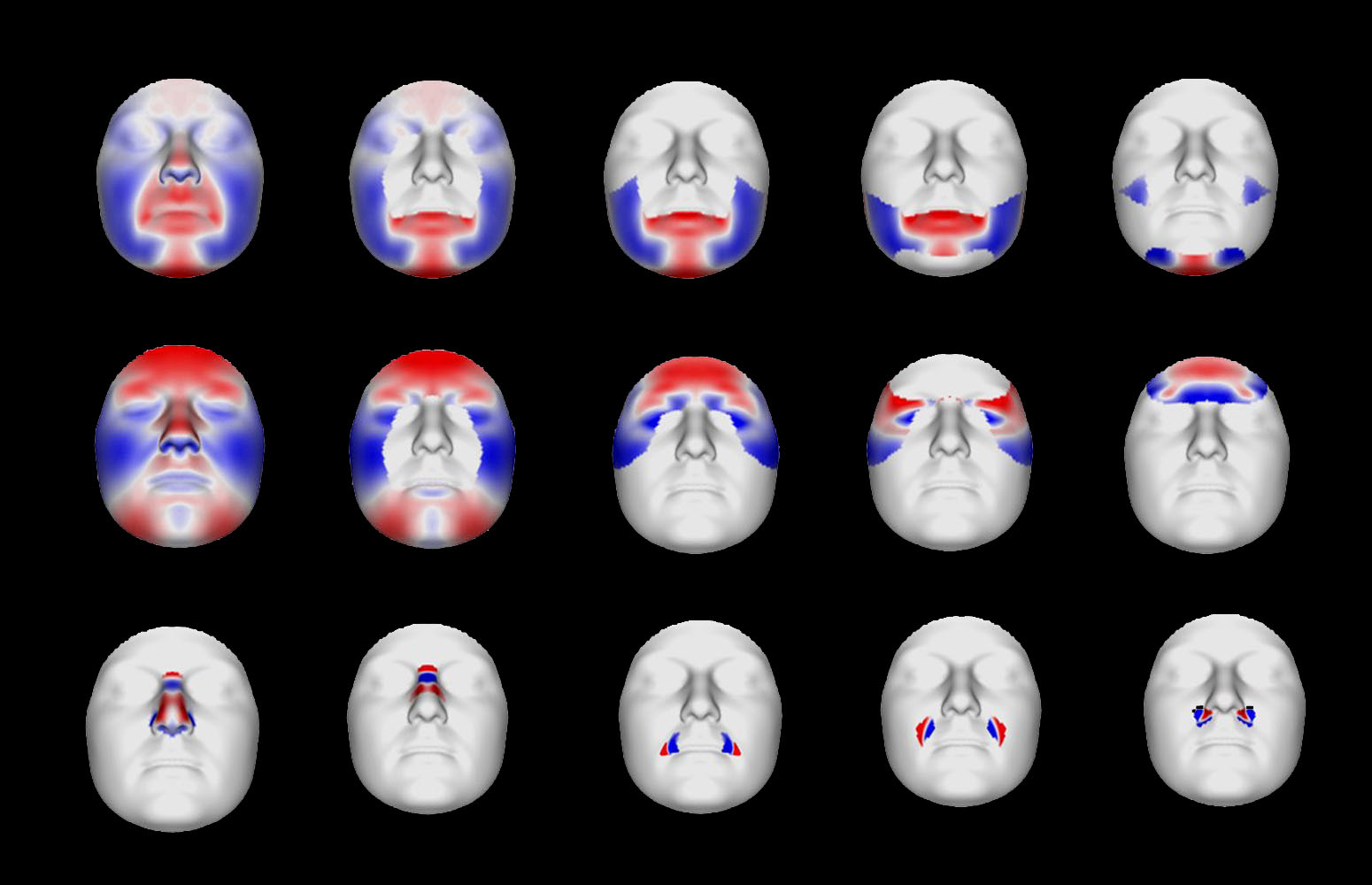New jet stream discovered in Jupiter's upper atmosphere
The UPV/EHU's Planetary Sciences Group is leading the discovery made by an international team and based on the analysis of observations obtained by the James Webb Space Telescope
- News
First publication date: 20/10/2023

High-speed jet streams are a common feature in the atmospheres of many planets. On the Earth, jet streams form at various latitudes and meander around the planet, changing latitude and reaching speeds approaching 400 km/h at an altitude of over 10 km above the surface. On the giant planets Jupiter and Saturn, jet streams are one of the main features of the atmosphere; they are perfectly aligned with the parallels, and are known as zonal jets. On Jupiter these jets alternate in direction at different latitudes reaching maximum speeds close to 500 km/h.

Image 1: Image of Jupiter obtained by the JWST and published in August last year. Acknowledgements: NASA/ESA/CSA and Jupiter Early Release Science team. Processed: Judy Schmidt (Planetary Society) and Ricardo Hueso (UPV/EHU).
On 27 July 2022, the James Webb Space Telescope (JWST) observed the atmosphere of Jupiter as part of an international "Early Science" programme in which researchers from the Planetary Sciences Group of the University of the Basque Country (UPV/EHU) are participating. Ricardo Hueso, lecturer at the Faculty of Engineering - Bilbao, designed and led the analysis of the sequence of images that the JWST had acquired of the planet. The analysis of the data, now published by the journal Nature Astronomy shows the discovery of a jet stream in Jupiter's atmosphere that had gone unnoticed for decades. Agustín Sánchez-Lavega and Arrate Antuñano-Martín, lecturers at the Faculty of Engineering - Bilbao, also participated in the discovery.

Image 2: Images of Jupiter obtained by the JWST (Left) False colour composition. (Centre) Image obtained at a wavelength sensitive to the upper clouds. (Right) Image obtained at a wavelength sensitive to the lower clouds. Acknowledgements: NASA/ESA/CSA and Jupiter Early Release Science team. Processed: Ricardo Hueso (UPV/EHU).
A dark Jupiter for a bright telescope
Because Jupiter is a very bright target for the JWST (whose light-collecting area is 6.3 times bigger than that of the Hubble Space Telescope), the images were acquired at wavelengths in which most of the light is absorbed by gases in the atmosphere. So the observations focused on the wavelengths in which Jupiter is darkest. This also meant that at many of these wavelengths Jupiter had never been observed with the quality needed to resolve the details of the weather systems in its atmosphere. Thanks to the JWST's features, a three-dimensional view of Jupiter's weather systems could be obtained: higher clouds appear bright in these images, and deeper clouds appear as dark regions. The JWST observations were also designed to obtain a measurement of the movements of the atmosphere by taking two sets of images separated by a full rotation of the planet, thus enabling a detailed study to be made of the cloud movements.

Image 3: Structure of the zonal winds on Jupiter from observations at visible wavelengths (white profile) and in different filters used in the study (coloured lines as indicated in the figure). The background image is a combination of JWST images sensitive to the upper clouds. Left-hand panel: General structure of the zonal winds. Right-hand panel: Equatorial region with the new jet stream observed in the upper clouds. Acknowledgements: NASA/ESA/CSA and Jupiter Early Release Science team.
A new jet stream on the planet's equator
The JWST images showed that the movements that occur in the clouds covering the equator are very different from those observed in the lower clouds. These clouds are so faint that no details can be seen in them in observations obtained from the Earth or even by different space missions. However, the detailed JWST images show that at the level of these clouds, winds reach speeds of 500 km/h, while in the lower clouds, located 30 km below, they only reach 250 km/h.
A universal phenomenon in Gas Giants
The study published in Nature Astronomy compares this new Jupiter jet with the structure of the equatorial jet stream of the gas giant Saturn, where in 2009 the UPV/EHU’s Planetary Sciences Group found a wind structure very similar to the one now revealed on Jupiter, and discovered on Saturn thanks to observations made by NASA's Cassini space probe [2-3]. On both planets, there is a fast, narrow equatorial jet at an altitude of about 200 mbar tracked by the rapid movement of equatorial clouds. On both Jupiter and Saturn, the elevated equatorial jets may be related to global temperature variations occurring in the atmospheres of these planets on a cyclical basis every few years, but which were thought to be limited in altitude at stratospheric levels to altitudes of 30-150 km above the level of the new equatorial jet stream. If the new Jupiter jet is related to these temperature oscillations in the upper atmosphere, then the equatorial jet stream should have a variable intensity on both Jupiter and Saturn, and also at much deeper levels than can be explained by existing atmospheric models. These intriguing phenomena occur near the tropopause of Jupiter and Saturn, precisely where the atmospheric dynamics change due to the fading effect of the Coriolis forces, and where the thermal properties of the atmosphere change dramatically. Future JWST observations of both Jupiter and Saturn may shed new light on these phenomena.
Bibliographic reference
- An intense narrow equatorial jet in Jupiter’s lower stratosphere observed by JWST
- Nature Astronomy
- DOI: 10.1038/s41550-023-02099-2
- A strong high altitude narrow jet detected at Saturn's equator
- Geophysical Research Letters
- DOI: 10.1029/2010GL045434
- An enduring rapidly moving storm as a guide to Saturn's Equatorial jet's complex structure
- Nature Communications
- DOI: 10.1038/ncomms13262



